In the copy of The Listener from March 1941, there is a piece by the artist Keith Henderson on his first year as a War Artist with the Air Ministry.
Before any artists had been appointed by the Air Ministry, William Rothenstein had requested permission to make portraits of airmen at bases in Scotland. Rothenstein pre-empted Keith Henderson, the official artist, in working at Leuchars base, which meant there was nothing for Henderson to do; Rothenstein was often referred to in print as an “official artist”, although at this time, it was not the case.
Henderson was one of the first two artists, alongside Paul Nash, appointed as a full-time salaried artist to the Air Ministry by the War Artists’ Advisory Committee, WAAC. Rothenstein’s work ended up with Henderson having to concentrate on ground crew, aircraft hangars, repair shops and runways for subjects. Although the painting ‘An Improvised Test of an Under-carriage’ provoked fury in the Air Ministry and contributed to Henderson’s six-month contract not being extended, it was among the artworks shown at the first WAAC ‘Britain at War’ exhibition at the Museum of Modern Art in New York in May 1941. The painting shows a man jumping up and down on the wing of a Lockheed-Hudson to test the undercarriage.
Keith Henderson was a Scottish painter who worked in both oils and watercolours, and who is known for his book illustrations and his poster work. He had a long professional career that included periods as a war artist in both the First World War, in which he served in the trenches, and in the Second World War. The muted colours and tones of his work remind me of Eric Ravilious, it is that style too, but Henderson’s work was between Ravilious and Christopher R. W. Nevinson.
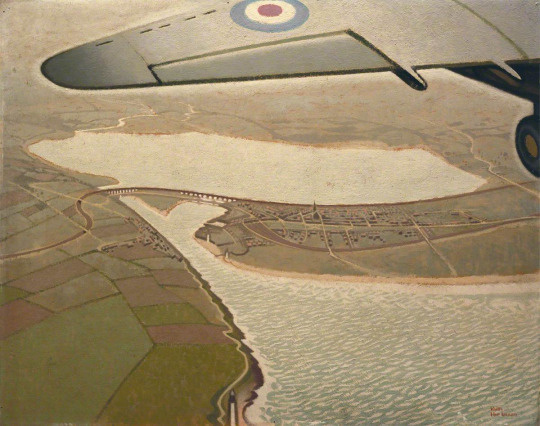
Keith Henderson – An Air View of Montrose, Angus, 1940.
War-time notes of a Peaceful Artist.
Turning over the pages of a diary that I began last April on being appointed one of the two official artists to the Air Ministry, I now read over passages here and there with reminiscent amusement and, yes, a certain genuine pleasure too. During the last war I kept a diary, not only while with my regiment but after being seconded to Intelligence with the XV Corps Squadron, and then Fifth Army Headquarters. The new diary, the one for this war, begins:

Keith Henderson – A North-East Coast Aerodrome, 1940.
April 19, 1940. Started with Helen from home yesterday evening towards the east coast, leaving snow on our Lochaber mountains and daffodils under the wintry trees. Curlews calling from every direction. Tomorrow…
April 20. This my first day of official duty has been a hideous failure. A guard at the aerodrome entrance, I drive in superior and nonchalant, returning the sentry’s salute. On to the Orderly Room. Adjutant, Commanding Officer, Intelligence Officers. Nervous as a cat, I hope they will not see through my calm affability. Cigarettes and a stroll towards the Mess. The ante-room is enormous: African buck, markhor, and other trophies of the chase branch out one above the other towards a lofty ceiling. The leather armchairs are so ample that officers reclining in them appear to be asleep. Crowds of others standing about, all very much alike. They observe that the Commanding Officer has a guest. Introductions, a glass of sherry. Presently through swing doors into the Mess Room, which is enormous. Lunch with one of the Wing Commanders, very friendly. But the afternoon, oh, the afternoon was hell. During a conducted tour round the hangars l saw nothing whatever that I particularly wanted to paint. The wind was hideously cold, the light bleak, and I had an exhausting stomach-ache. Violent and continuous noises of engines being tested. No ideas.
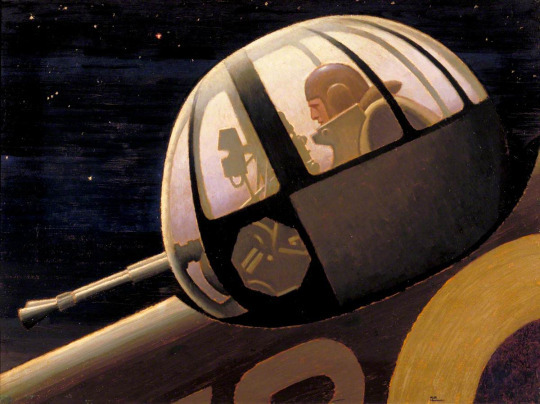
Keith Henderson – Night: An Air Gunner in Auction Turret, 1940.
April 22. Serene spring weather. All has gone well, so well that I’have had to steady myself with thoughts of the horror of the conquered in Poland, Norway, and elsewhere. A man’s philosophy is usually in accord’ with his circumstances, both interior and exterior. Optimists do not have stomach-aches. Mine had vanished. From the high control tower at least three marvellous possibilities appeared. Two sinister and monstrous bombers were awkwardly entering their hangar. They have the eyes, the mouths, legs, bodies, wings of elephantine obscene. insects, but stupid insects. Prod them and they will not move away or retaliate. There is no mind within. They are utterly vacant. I must paint them like that. How lucky am I to have been appointed to this delightful work.
April 24. Three pictures have now been begun. I am using a monochrome mixture of white, yellow-ochre, and a little raw umber. This will make any alterations to the composition easier before a more or less rapid final painting begins.
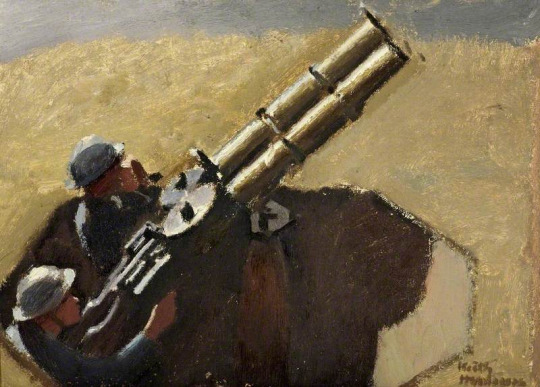
Keith Henderson – Study of Royal Air Force Machine Gunmen, 1939.
May 5. From the ground this strangely retarded spring is at last clearly visible. Trees are in bud and millions of small dowers give an impression of Chaucerian gaiety. Up in the air scarcely any of this tiny brilliance shows yet. There are just stretches of moorland and of ploughland in various shades of pale buff and maroon, with here a diaper dressing of lime, there a flutter of gulls, a few sombre forestry plantations and many lesser woods wherein only’an occasional pale willow is conspicuous, old stone farmhouses with their haystacks in rows, a ruin near a newer castellated mansion, small lochs all silvery grey, an appearance of desertion far and wide. From the air the earth has no flowers. Eastward is the wonderful coast-line, red sandstone mostly, fretted away into natural arches and pinnacles. The jade green sea is as lovely from above as I remember it in the last war. Those white festooned breakers along the Beaches seem without sound.
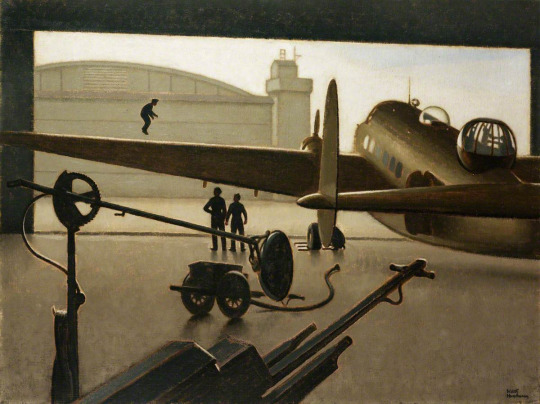
Keith Henderson – An Improvised Test of an Undercarriage, 1940.
May 6. Today I tried the experiment of taking up more than mere notebooks. I took a canvas, a dozen brushes and a full set palette. The Palette was disastrous. Within a few moments of taking off, I noticed Indian red on my sleeve. The observer crept forward to the navigator’s seat where I was, and shouted into my ear, ‘Have you got everything you want?’ ‘Yes, thank you’ I shouted back, ‘but you have got some ultramarine on your cheek. I remembered noticing an air gunner holding the palette at a dangerously acute angle as he handed it to someone. And worse. Nearly all the so carefully arranged large clumps of paint round the palette’s edge were, I saw now with dismay, gone. They had evidently slipped off or been smeared off. But I could not be Without them. They must be found, scraped up penuriously from the floor or anywhere. Then I saw the legs of the air gunner. My precious cadmium red! The observer, the pilot even, all were strangely daubed handed round proved in that cramped space more distributive than cleansing. Their hands, their faces, their flying kit were crimson, blue, white, black, yellow, or tartan. It was a great success.
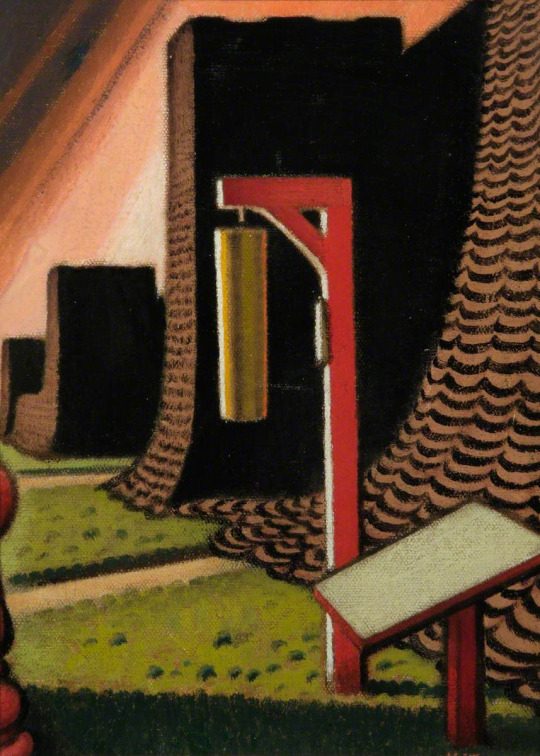
Keith Henderson – Camouflage Hangars and Gas Gong, 1940.
May 7. My bedroom at the aerodrome is quite comfortable. I shall never forget my astonishment when an efficient batman offered me early tea. I was then getting up at 4 am. for a dawn picture. This morning it had to be 3.30. As we rose into the upper air through ground mist three swans also rose through the ground mist. They Hew north. I found myself thinking: ‘Where exactly is the centre of the Universe?’ And I answered myself: ‘ Wherever you happen to be at the moment’. In mid air ’the centre of the Universe is definitely not on the earth’s surface. All who fly will agree about that. Suppose yourself flying west. You wish to turn south. The great rigid wings slant over. But for all the planetary pull of gravitation, it is not the aircraft which appears to be askew. Not at all. The earth on the other hand has gone mad. It has heaved itself up, sea and all, steeply into space, a huge menacing wave that will not subside until the dial shows the wings horizontal. They will be in a moment. Now they are. Now the earth is itself again, flat, detached inhuman, without laughter or any birds singing.
May 8. A letter from the Air Ministry. I wrote some time ago ‘asking for permission to go to Narvik or Stavanger on a bombing raid’. The Air Commodore at Whitehall answers, ‘Under present conditions it is quite out of the question that you should visit Norway‘. Right. Well, that exonerates me. I am certainly not going to do fancy war pictures from photographs and descriptions.
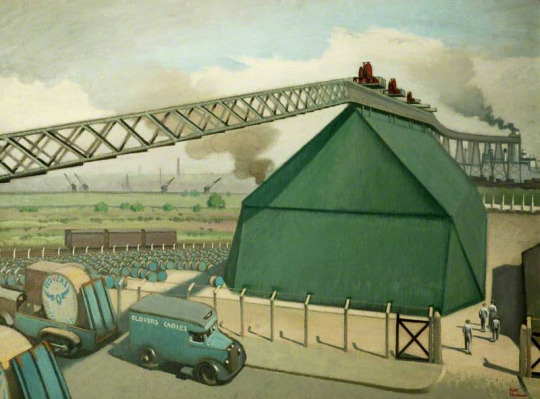
Keith Henderson – Loading Gantry for Pluto, 1940.
May 9. Home for another short rest, tired. No, not depressed. There must be no regretting all that I have not accomplished, but simply a ‘proud delight in all that I have accomplished. Let me be luxuriously lazy. For several days on end I need not do anything. I loll in this white window Seat looking down the length of the room towards Aunt Nell‘s two rococo mirrors on either side of the Chinese lacquer cabinet. One of the dogs in the farmyard barks. I love the faint pink, wallpaper with its bunches of blue-grey and white flowers. I am happy. I think I have been asleep. I must go and see how things are coming on in the walled garden.
May 11. Back at the aerodrome. The usual crowds assemble as soon as I set up my easel for a large picture to be called ‘Repairs to a Bomber’. Since last night when I came round to see that all was in order, the men have produced, in the most frightful raw flat yellow, on the side of the particular aircraft that I am painting, a huge figure of Donald Duck. They want me to put this into the picture, but I really cannot. It would spoil the whole thing. The effort to find words that might show them why it would spoil the whole thing is almost too much during working hours.
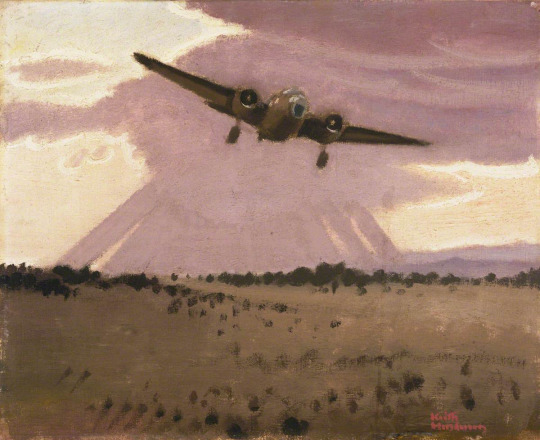
Keith Henderson – Dawn: Leaving for North Sea Patrol, 1940.
May 12. On other machines they have now painted other grotesques, including the wholly inexcusable Popeye. A sergeant pilot says that these effigies will ‘cheer up the Jerries’. And this while the news becomes more serious than any news ever announced in the world before.
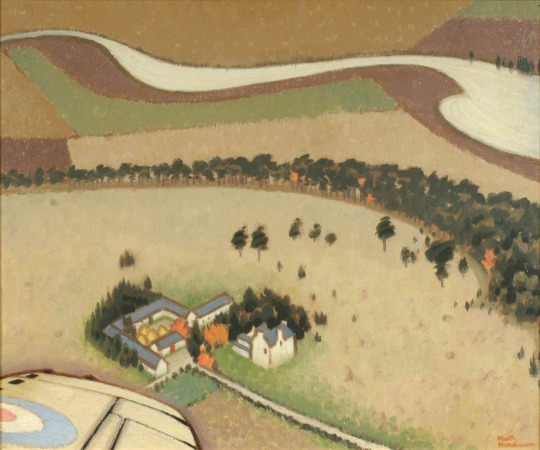
Keith Henderson – Wings over Scotland, 1940.
May 16. While I was touching in the ‘horns’ of the bomber a young pilot who had been standing beside me asked: ‘How do you begin a picture?’ My answer, which was regrettably long, failed to give satisfaction. I could feel that. There was silence; and then – would I come for a flit with him? When? This afternoon? Well, I did rather want to get on with that thing of the coastline…. He went off at once and came back to say that all had been fixed. We were to go in the Jewel. On my way to the Mess I reflected that a machine called the Jewel sounded pleasantly airworthy. Later I discovered my mistake. Not Jewel, but Dual, a machine with dual control. ‘You must take a turn’, he offered. I made no answer, doubtful as to what this implied. When the parachutes and Mae Wests and other paraphernalia for all concerned are collected we drive across to the Dual. The engines have of course been sending out dust gales to the rear for a good while. We heave ourselves in. Before taking off, the pilot looks round and holds up his right thumb. The rest of the crew hold up theirs. All is well. The noise increases, is doubled, trebled, deafening in spite of ear plugs. We are moving forward, moving more swiftly. We have left the ground. As soon as we are at the right height I begin sketching. The time goes by. I muse vaguely about art meanwhile. Art is more than national, more than international; it is supernatural-magic-always* has been since cave days, always will be. There. The drawings are finished. We may return. Presently the pilot nudges my elbow. I am sitting on the learner’s seat close beside him. What is it now? What? He points to the controls and points at me. Does he mean that I am to ‘take a turn’? I hesitate. His reply to my very sensible hesitation is to cross his arms and lean heavily with his head on one side as if sound asleep. Something must be done. I seize the crescent. He is awake again, ready. We have lost height. I pull back. We rise, rise higher. The North Sea is empty of shipping. No, there’s a distant convoy. So it is. This is rather delightful. At a pinch, if the pilot were to become a casualty, could I carry on ? I might, I really might. But I certainly could not land. I should just have to go on and on, flying round the world indefinitely.
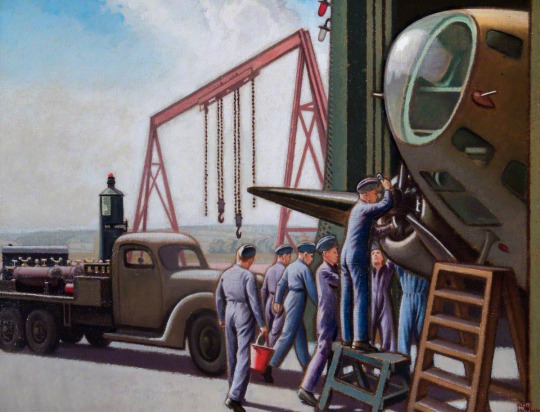
Keith Henderson – Repairs to a Bomber, 1941.
May 23. Abbeville fallen. Boulogne fallen. Well, as to our next move, that rests with the Higher Command, not with me. Defeat ? That is an idea that I’ve never even glanced at. Have any of us ? Probably not. Better not. In the evening I have just finished a life of Wallenstein, and am beginning Lady Mary Wortley Montague’s Letters.
June 13. At home fér another rest. More carrots sown and the artichokes, thinned out to three feet apart, should do well. The Germans are only sixteen miles from Paris.

Keith Henderson – Gas Practice in a Hangar, 1940.
June 14. The first flowers of Campanula Carpatica have appeared, and Helen this afternoon made a delicious cinnamon cake. All down the steep brae towards the river there are foxgloves in full bloom. While raking beechmast into heaps on either side of the drive, I have been watching the cows. They are let out from the byre. They walk very slowly for about five yards, looking straight ahead. Then one of them stops. Gradually they all stop. Why? Two of them move slowly forward a few steps. A long pause. A few others follow and stop again. Another long pause. Do they want to go anywhere in particular? Why need they? A strawberry Ayrshire slowly turns her head. She looks at me for a long while without interest. Then she turns away, having learned nothing. They have nothing to do all day long. A black Galloway, with bracken in her tail, sits down, slowly and heavily. Five minutes later a polled Angus sits down, slowly and heavily. At the end of half-an-hour they have all sat down. Absolute peace here, and news has just come that the Germans have entered Paris.
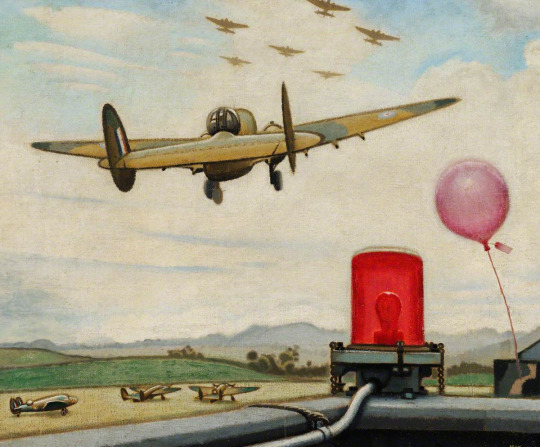
Keith Henderson – Ascent of the Met Balloon, 1940.
So the diary goes on – a continual contrast between busy warlike aerodromes and exquisite days on leave. That was almost a year ago. How angry we felt then and how obstinate. Today, even more angry and more obstinate, we are surely, I think, feeling much more hopeful. –
The painting ‘An Improvised Test of an Under-carriage’ provoked fury in the Air Ministry and his six month contract as a war artist had come to an end. His work was exhibited at the time but unlike Eric Ravilious his work has more or less been ignored.
*not a typo.